Operations Management and Service Excellence at Starbucks and Greggs
VerifiedAdded on 2023/01/17
|15
|4328
|70
Report
AI Summary
This report provides a comprehensive analysis of Starbucks' operations management and service excellence, comparing its strategies and performance with Greggs. The report begins with an introduction to operations management and service excellence, then proceeds to a detailed Four Vs analysis, comparing Starbucks and Greggs based on volume, variety, variation, and visibility. A comparative performance objectives analysis is conducted, evaluating both companies across cost, dependability, flexibility, speed, and quality. The design analysis examines customer service processes and store layouts. Part 2 focuses on Starbucks' global operations strategy, key requirements, capabilities, and challenges, followed by an analysis and evaluation of a chosen operational area, and concluding with recommendations.
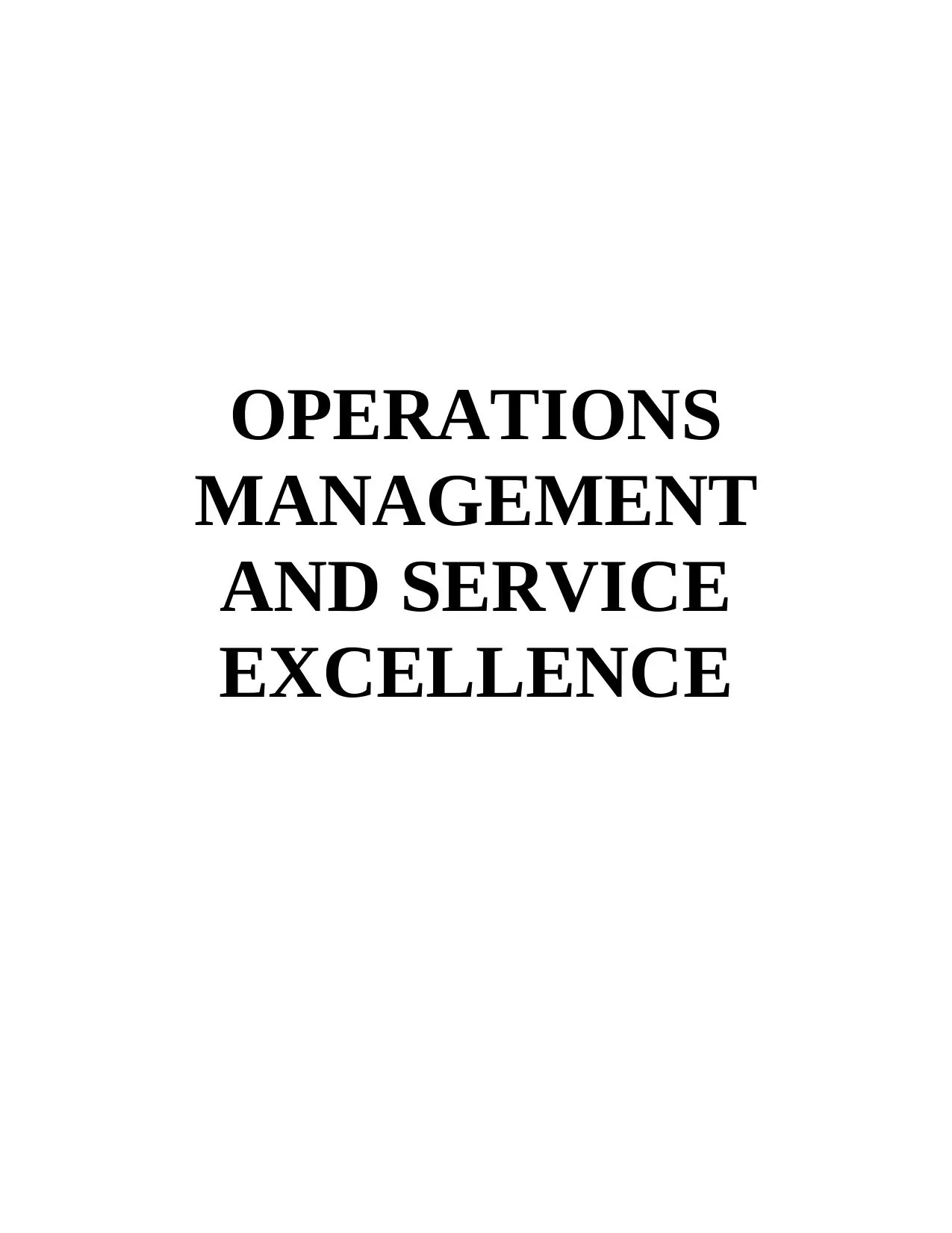
OPERATIONS
MANAGEMENT
AND SERVICE
EXCELLENCE
MANAGEMENT
AND SERVICE
EXCELLENCE
Paraphrase This Document
Need a fresh take? Get an instant paraphrase of this document with our AI Paraphraser
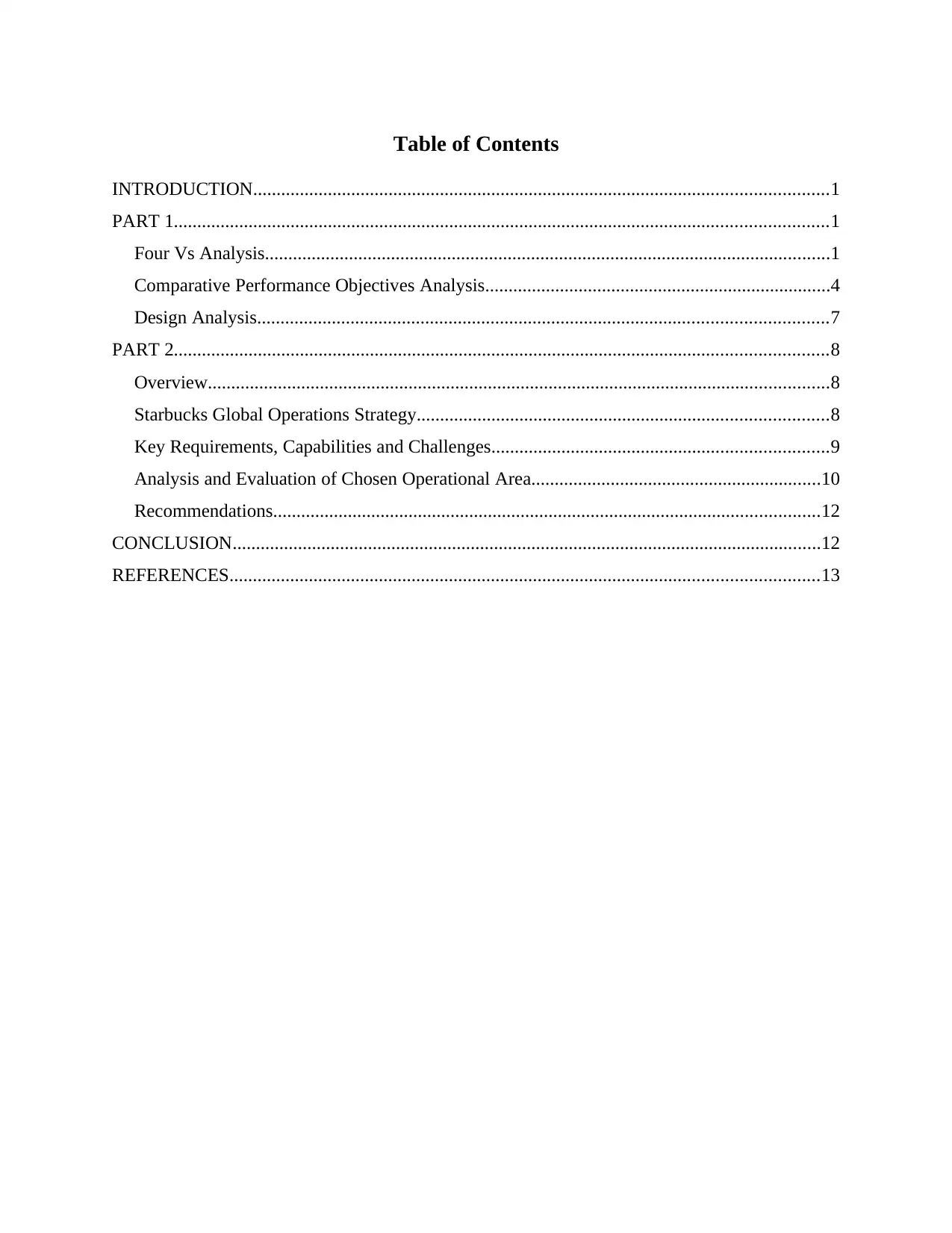
Table of Contents
INTRODUCTION...........................................................................................................................1
PART 1............................................................................................................................................1
Four Vs Analysis.........................................................................................................................1
Comparative Performance Objectives Analysis..........................................................................4
Design Analysis..........................................................................................................................7
PART 2............................................................................................................................................8
Overview.....................................................................................................................................8
Starbucks Global Operations Strategy........................................................................................8
Key Requirements, Capabilities and Challenges........................................................................9
Analysis and Evaluation of Chosen Operational Area..............................................................10
Recommendations.....................................................................................................................12
CONCLUSION..............................................................................................................................12
REFERENCES..............................................................................................................................13
INTRODUCTION...........................................................................................................................1
PART 1............................................................................................................................................1
Four Vs Analysis.........................................................................................................................1
Comparative Performance Objectives Analysis..........................................................................4
Design Analysis..........................................................................................................................7
PART 2............................................................................................................................................8
Overview.....................................................................................................................................8
Starbucks Global Operations Strategy........................................................................................8
Key Requirements, Capabilities and Challenges........................................................................9
Analysis and Evaluation of Chosen Operational Area..............................................................10
Recommendations.....................................................................................................................12
CONCLUSION..............................................................................................................................12
REFERENCES..............................................................................................................................13
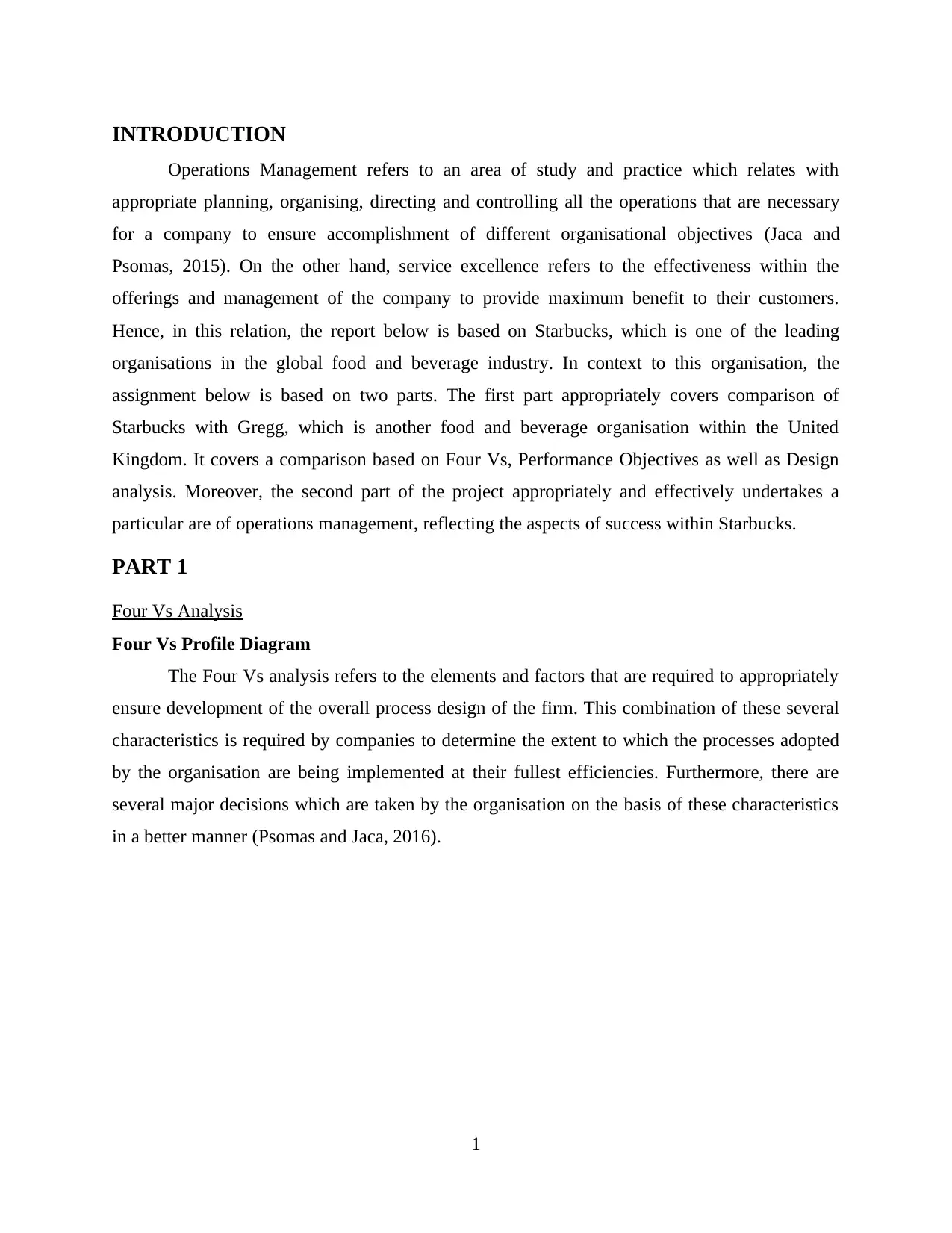
INTRODUCTION
Operations Management refers to an area of study and practice which relates with
appropriate planning, organising, directing and controlling all the operations that are necessary
for a company to ensure accomplishment of different organisational objectives (Jaca and
Psomas, 2015). On the other hand, service excellence refers to the effectiveness within the
offerings and management of the company to provide maximum benefit to their customers.
Hence, in this relation, the report below is based on Starbucks, which is one of the leading
organisations in the global food and beverage industry. In context to this organisation, the
assignment below is based on two parts. The first part appropriately covers comparison of
Starbucks with Gregg, which is another food and beverage organisation within the United
Kingdom. It covers a comparison based on Four Vs, Performance Objectives as well as Design
analysis. Moreover, the second part of the project appropriately and effectively undertakes a
particular are of operations management, reflecting the aspects of success within Starbucks.
PART 1
Four Vs Analysis
Four Vs Profile Diagram
The Four Vs analysis refers to the elements and factors that are required to appropriately
ensure development of the overall process design of the firm. This combination of these several
characteristics is required by companies to determine the extent to which the processes adopted
by the organisation are being implemented at their fullest efficiencies. Furthermore, there are
several major decisions which are taken by the organisation on the basis of these characteristics
in a better manner (Psomas and Jaca, 2016).
1
Operations Management refers to an area of study and practice which relates with
appropriate planning, organising, directing and controlling all the operations that are necessary
for a company to ensure accomplishment of different organisational objectives (Jaca and
Psomas, 2015). On the other hand, service excellence refers to the effectiveness within the
offerings and management of the company to provide maximum benefit to their customers.
Hence, in this relation, the report below is based on Starbucks, which is one of the leading
organisations in the global food and beverage industry. In context to this organisation, the
assignment below is based on two parts. The first part appropriately covers comparison of
Starbucks with Gregg, which is another food and beverage organisation within the United
Kingdom. It covers a comparison based on Four Vs, Performance Objectives as well as Design
analysis. Moreover, the second part of the project appropriately and effectively undertakes a
particular are of operations management, reflecting the aspects of success within Starbucks.
PART 1
Four Vs Analysis
Four Vs Profile Diagram
The Four Vs analysis refers to the elements and factors that are required to appropriately
ensure development of the overall process design of the firm. This combination of these several
characteristics is required by companies to determine the extent to which the processes adopted
by the organisation are being implemented at their fullest efficiencies. Furthermore, there are
several major decisions which are taken by the organisation on the basis of these characteristics
in a better manner (Psomas and Jaca, 2016).
1
⊘ This is a preview!⊘
Do you want full access?
Subscribe today to unlock all pages.

Trusted by 1+ million students worldwide
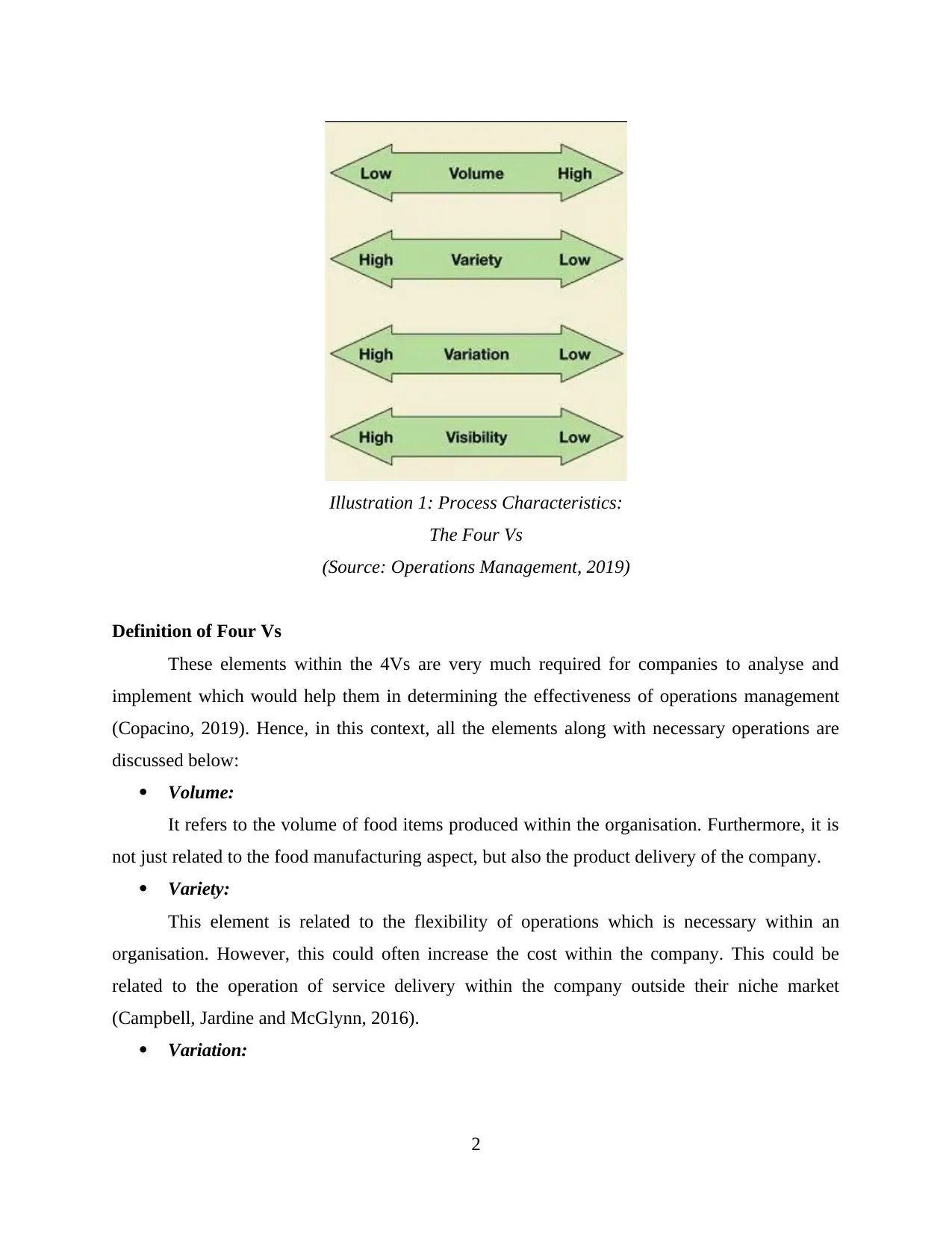
Illustration 1: Process Characteristics:
The Four Vs
(Source: Operations Management, 2019)
Definition of Four Vs
These elements within the 4Vs are very much required for companies to analyse and
implement which would help them in determining the effectiveness of operations management
(Copacino, 2019). Hence, in this context, all the elements along with necessary operations are
discussed below:
Volume:
It refers to the volume of food items produced within the organisation. Furthermore, it is
not just related to the food manufacturing aspect, but also the product delivery of the company.
Variety:
This element is related to the flexibility of operations which is necessary within an
organisation. However, this could often increase the cost within the company. This could be
related to the operation of service delivery within the company outside their niche market
(Campbell, Jardine and McGlynn, 2016).
Variation:
2
The Four Vs
(Source: Operations Management, 2019)
Definition of Four Vs
These elements within the 4Vs are very much required for companies to analyse and
implement which would help them in determining the effectiveness of operations management
(Copacino, 2019). Hence, in this context, all the elements along with necessary operations are
discussed below:
Volume:
It refers to the volume of food items produced within the organisation. Furthermore, it is
not just related to the food manufacturing aspect, but also the product delivery of the company.
Variety:
This element is related to the flexibility of operations which is necessary within an
organisation. However, this could often increase the cost within the company. This could be
related to the operation of service delivery within the company outside their niche market
(Campbell, Jardine and McGlynn, 2016).
Variation:
2
Paraphrase This Document
Need a fresh take? Get an instant paraphrase of this document with our AI Paraphraser
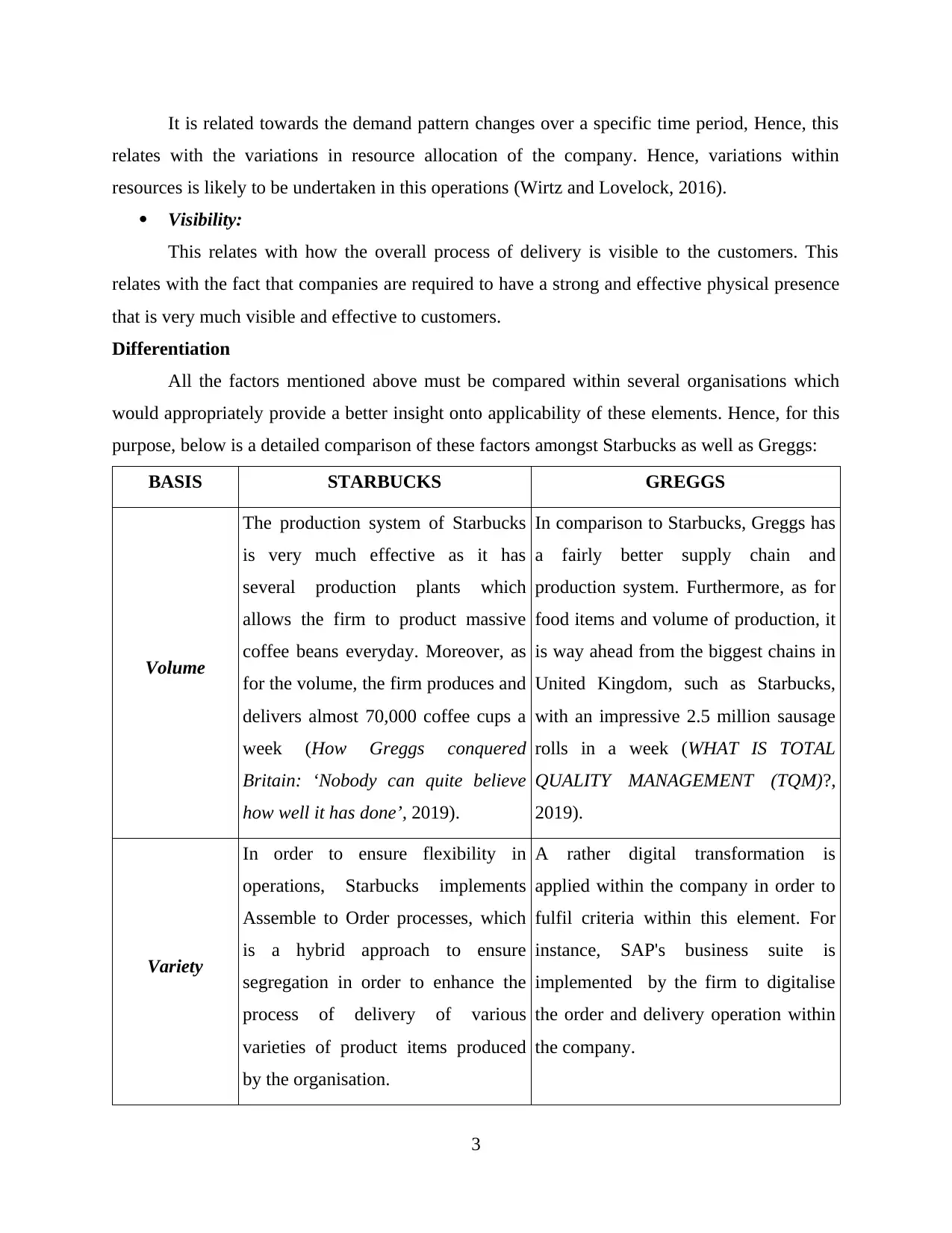
It is related towards the demand pattern changes over a specific time period, Hence, this
relates with the variations in resource allocation of the company. Hence, variations within
resources is likely to be undertaken in this operations (Wirtz and Lovelock, 2016).
Visibility:
This relates with how the overall process of delivery is visible to the customers. This
relates with the fact that companies are required to have a strong and effective physical presence
that is very much visible and effective to customers.
Differentiation
All the factors mentioned above must be compared within several organisations which
would appropriately provide a better insight onto applicability of these elements. Hence, for this
purpose, below is a detailed comparison of these factors amongst Starbucks as well as Greggs:
BASIS STARBUCKS GREGGS
Volume
The production system of Starbucks
is very much effective as it has
several production plants which
allows the firm to product massive
coffee beans everyday. Moreover, as
for the volume, the firm produces and
delivers almost 70,000 coffee cups a
week (How Greggs conquered
Britain: ‘Nobody can quite believe
how well it has done’, 2019).
In comparison to Starbucks, Greggs has
a fairly better supply chain and
production system. Furthermore, as for
food items and volume of production, it
is way ahead from the biggest chains in
United Kingdom, such as Starbucks,
with an impressive 2.5 million sausage
rolls in a week (WHAT IS TOTAL
QUALITY MANAGEMENT (TQM)?,
2019).
Variety
In order to ensure flexibility in
operations, Starbucks implements
Assemble to Order processes, which
is a hybrid approach to ensure
segregation in order to enhance the
process of delivery of various
varieties of product items produced
by the organisation.
A rather digital transformation is
applied within the company in order to
fulfil criteria within this element. For
instance, SAP's business suite is
implemented by the firm to digitalise
the order and delivery operation within
the company.
3
relates with the variations in resource allocation of the company. Hence, variations within
resources is likely to be undertaken in this operations (Wirtz and Lovelock, 2016).
Visibility:
This relates with how the overall process of delivery is visible to the customers. This
relates with the fact that companies are required to have a strong and effective physical presence
that is very much visible and effective to customers.
Differentiation
All the factors mentioned above must be compared within several organisations which
would appropriately provide a better insight onto applicability of these elements. Hence, for this
purpose, below is a detailed comparison of these factors amongst Starbucks as well as Greggs:
BASIS STARBUCKS GREGGS
Volume
The production system of Starbucks
is very much effective as it has
several production plants which
allows the firm to product massive
coffee beans everyday. Moreover, as
for the volume, the firm produces and
delivers almost 70,000 coffee cups a
week (How Greggs conquered
Britain: ‘Nobody can quite believe
how well it has done’, 2019).
In comparison to Starbucks, Greggs has
a fairly better supply chain and
production system. Furthermore, as for
food items and volume of production, it
is way ahead from the biggest chains in
United Kingdom, such as Starbucks,
with an impressive 2.5 million sausage
rolls in a week (WHAT IS TOTAL
QUALITY MANAGEMENT (TQM)?,
2019).
Variety
In order to ensure flexibility in
operations, Starbucks implements
Assemble to Order processes, which
is a hybrid approach to ensure
segregation in order to enhance the
process of delivery of various
varieties of product items produced
by the organisation.
A rather digital transformation is
applied within the company in order to
fulfil criteria within this element. For
instance, SAP's business suite is
implemented by the firm to digitalise
the order and delivery operation within
the company.
3
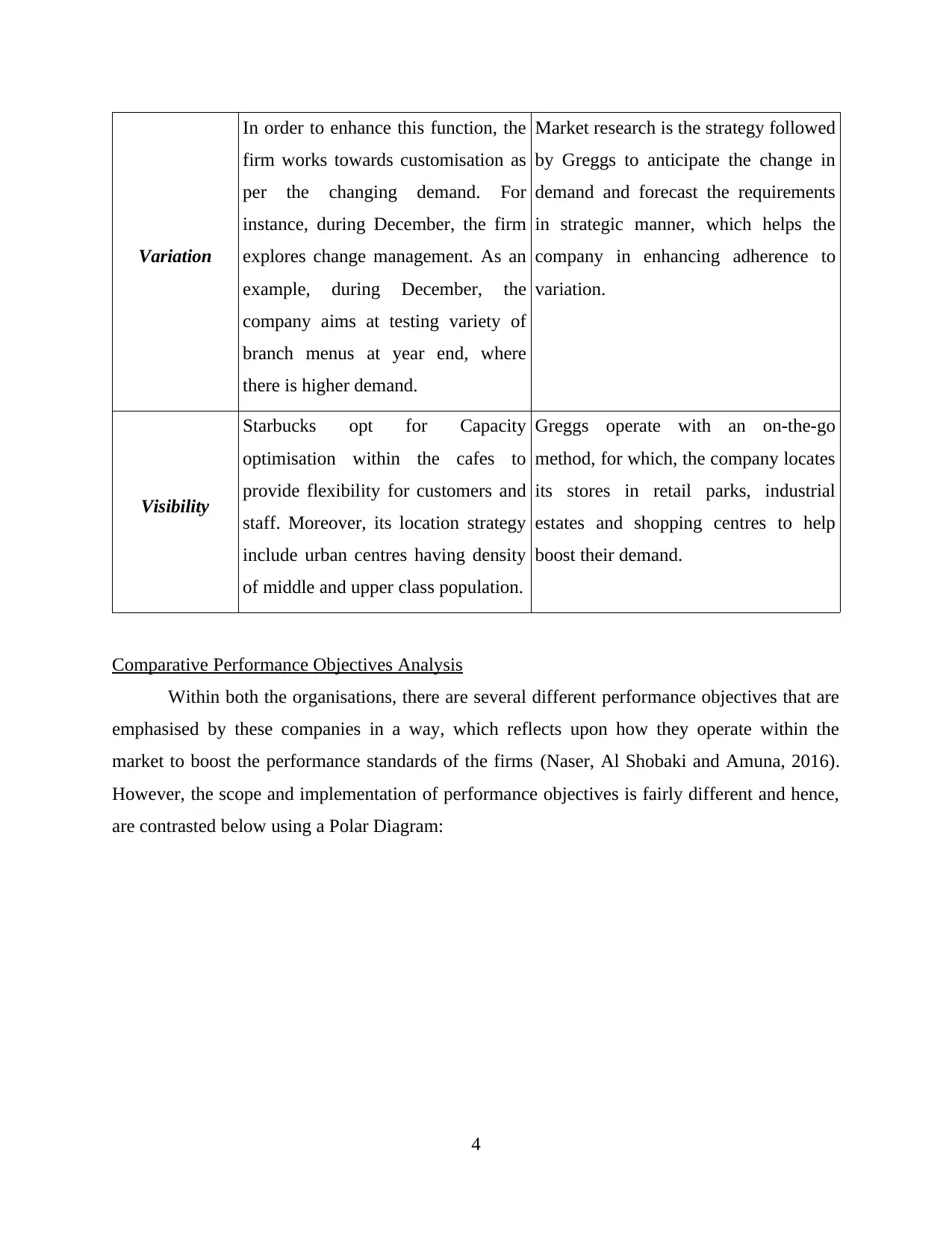
Variation
In order to enhance this function, the
firm works towards customisation as
per the changing demand. For
instance, during December, the firm
explores change management. As an
example, during December, the
company aims at testing variety of
branch menus at year end, where
there is higher demand.
Market research is the strategy followed
by Greggs to anticipate the change in
demand and forecast the requirements
in strategic manner, which helps the
company in enhancing adherence to
variation.
Visibility
Starbucks opt for Capacity
optimisation within the cafes to
provide flexibility for customers and
staff. Moreover, its location strategy
include urban centres having density
of middle and upper class population.
Greggs operate with an on-the-go
method, for which, the company locates
its stores in retail parks, industrial
estates and shopping centres to help
boost their demand.
Comparative Performance Objectives Analysis
Within both the organisations, there are several different performance objectives that are
emphasised by these companies in a way, which reflects upon how they operate within the
market to boost the performance standards of the firms (Naser, Al Shobaki and Amuna, 2016).
However, the scope and implementation of performance objectives is fairly different and hence,
are contrasted below using a Polar Diagram:
4
In order to enhance this function, the
firm works towards customisation as
per the changing demand. For
instance, during December, the firm
explores change management. As an
example, during December, the
company aims at testing variety of
branch menus at year end, where
there is higher demand.
Market research is the strategy followed
by Greggs to anticipate the change in
demand and forecast the requirements
in strategic manner, which helps the
company in enhancing adherence to
variation.
Visibility
Starbucks opt for Capacity
optimisation within the cafes to
provide flexibility for customers and
staff. Moreover, its location strategy
include urban centres having density
of middle and upper class population.
Greggs operate with an on-the-go
method, for which, the company locates
its stores in retail parks, industrial
estates and shopping centres to help
boost their demand.
Comparative Performance Objectives Analysis
Within both the organisations, there are several different performance objectives that are
emphasised by these companies in a way, which reflects upon how they operate within the
market to boost the performance standards of the firms (Naser, Al Shobaki and Amuna, 2016).
However, the scope and implementation of performance objectives is fairly different and hence,
are contrasted below using a Polar Diagram:
4
⊘ This is a preview!⊘
Do you want full access?
Subscribe today to unlock all pages.

Trusted by 1+ million students worldwide
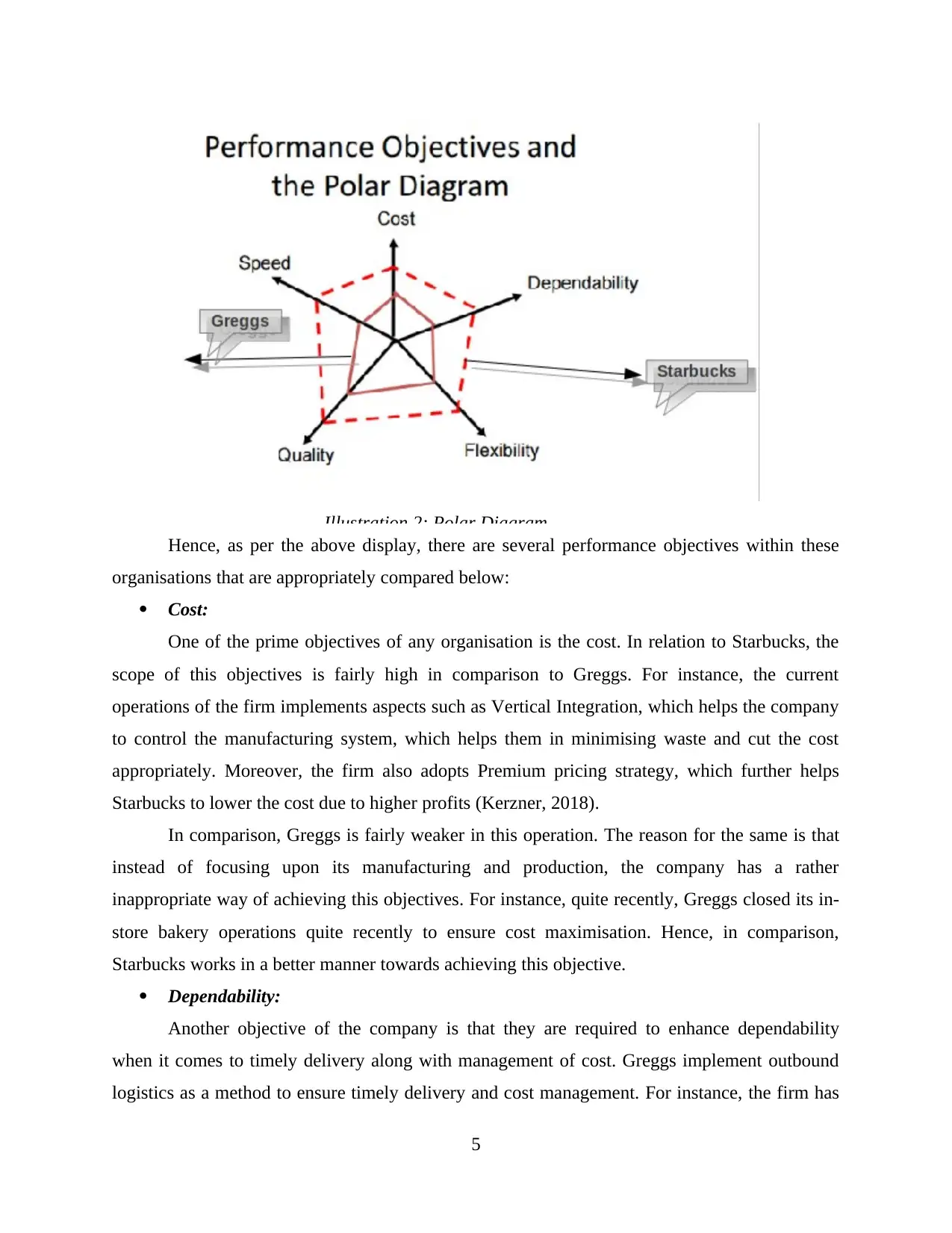
Illustration 2: Polar Diagram
Hence, as per the above display, there are several performance objectives within these
organisations that are appropriately compared below:
Cost:
One of the prime objectives of any organisation is the cost. In relation to Starbucks, the
scope of this objectives is fairly high in comparison to Greggs. For instance, the current
operations of the firm implements aspects such as Vertical Integration, which helps the company
to control the manufacturing system, which helps them in minimising waste and cut the cost
appropriately. Moreover, the firm also adopts Premium pricing strategy, which further helps
Starbucks to lower the cost due to higher profits (Kerzner, 2018).
In comparison, Greggs is fairly weaker in this operation. The reason for the same is that
instead of focusing upon its manufacturing and production, the company has a rather
inappropriate way of achieving this objectives. For instance, quite recently, Greggs closed its in-
store bakery operations quite recently to ensure cost maximisation. Hence, in comparison,
Starbucks works in a better manner towards achieving this objective.
Dependability:
Another objective of the company is that they are required to enhance dependability
when it comes to timely delivery along with management of cost. Greggs implement outbound
logistics as a method to ensure timely delivery and cost management. For instance, the firm has
5
Hence, as per the above display, there are several performance objectives within these
organisations that are appropriately compared below:
Cost:
One of the prime objectives of any organisation is the cost. In relation to Starbucks, the
scope of this objectives is fairly high in comparison to Greggs. For instance, the current
operations of the firm implements aspects such as Vertical Integration, which helps the company
to control the manufacturing system, which helps them in minimising waste and cut the cost
appropriately. Moreover, the firm also adopts Premium pricing strategy, which further helps
Starbucks to lower the cost due to higher profits (Kerzner, 2018).
In comparison, Greggs is fairly weaker in this operation. The reason for the same is that
instead of focusing upon its manufacturing and production, the company has a rather
inappropriate way of achieving this objectives. For instance, quite recently, Greggs closed its in-
store bakery operations quite recently to ensure cost maximisation. Hence, in comparison,
Starbucks works in a better manner towards achieving this objective.
Dependability:
Another objective of the company is that they are required to enhance dependability
when it comes to timely delivery along with management of cost. Greggs implement outbound
logistics as a method to ensure timely delivery and cost management. For instance, the firm has
5
Paraphrase This Document
Need a fresh take? Get an instant paraphrase of this document with our AI Paraphraser
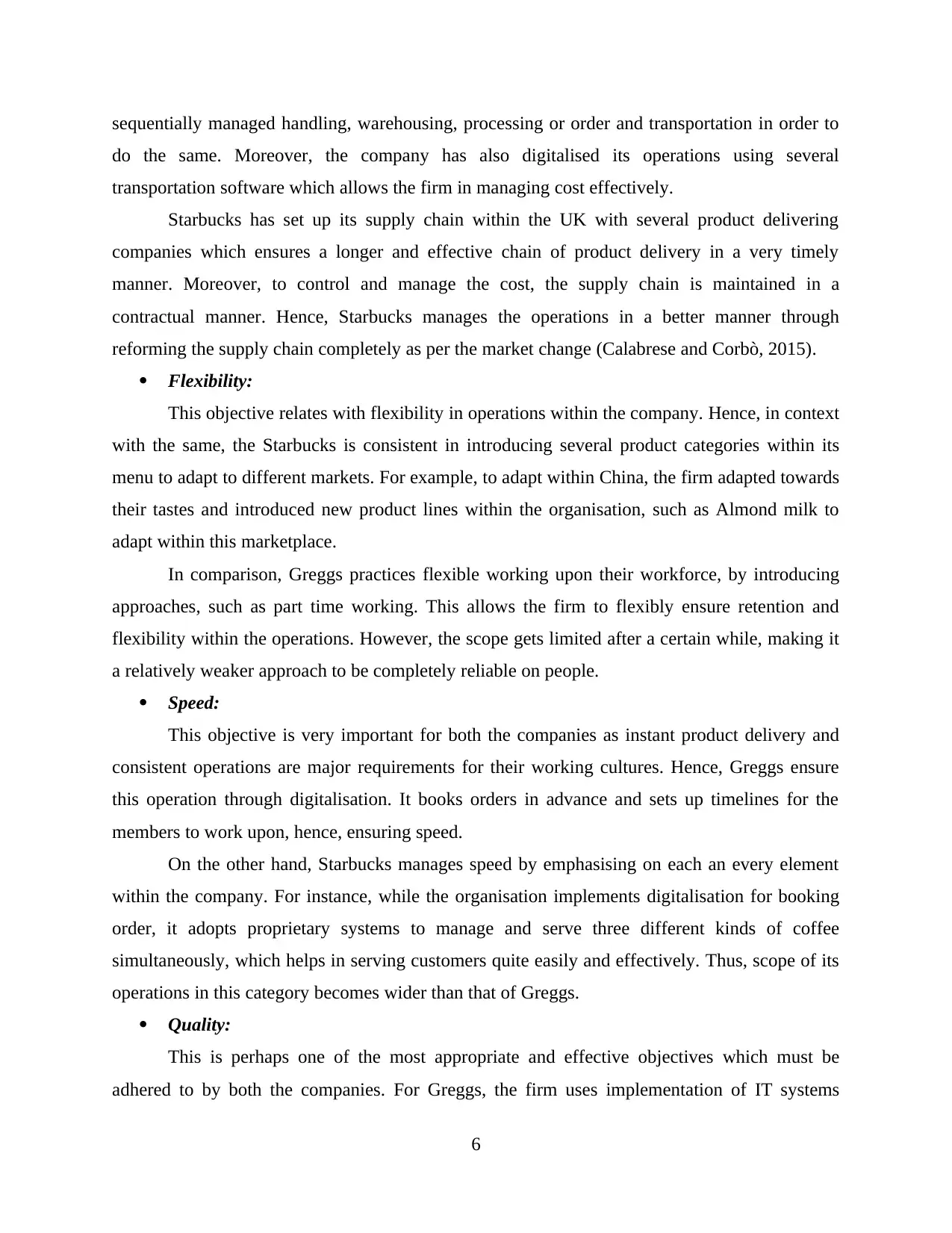
sequentially managed handling, warehousing, processing or order and transportation in order to
do the same. Moreover, the company has also digitalised its operations using several
transportation software which allows the firm in managing cost effectively.
Starbucks has set up its supply chain within the UK with several product delivering
companies which ensures a longer and effective chain of product delivery in a very timely
manner. Moreover, to control and manage the cost, the supply chain is maintained in a
contractual manner. Hence, Starbucks manages the operations in a better manner through
reforming the supply chain completely as per the market change (Calabrese and Corbò, 2015).
Flexibility:
This objective relates with flexibility in operations within the company. Hence, in context
with the same, the Starbucks is consistent in introducing several product categories within its
menu to adapt to different markets. For example, to adapt within China, the firm adapted towards
their tastes and introduced new product lines within the organisation, such as Almond milk to
adapt within this marketplace.
In comparison, Greggs practices flexible working upon their workforce, by introducing
approaches, such as part time working. This allows the firm to flexibly ensure retention and
flexibility within the operations. However, the scope gets limited after a certain while, making it
a relatively weaker approach to be completely reliable on people.
Speed:
This objective is very important for both the companies as instant product delivery and
consistent operations are major requirements for their working cultures. Hence, Greggs ensure
this operation through digitalisation. It books orders in advance and sets up timelines for the
members to work upon, hence, ensuring speed.
On the other hand, Starbucks manages speed by emphasising on each an every element
within the company. For instance, while the organisation implements digitalisation for booking
order, it adopts proprietary systems to manage and serve three different kinds of coffee
simultaneously, which helps in serving customers quite easily and effectively. Thus, scope of its
operations in this category becomes wider than that of Greggs.
Quality:
This is perhaps one of the most appropriate and effective objectives which must be
adhered to by both the companies. For Greggs, the firm uses implementation of IT systems
6
do the same. Moreover, the company has also digitalised its operations using several
transportation software which allows the firm in managing cost effectively.
Starbucks has set up its supply chain within the UK with several product delivering
companies which ensures a longer and effective chain of product delivery in a very timely
manner. Moreover, to control and manage the cost, the supply chain is maintained in a
contractual manner. Hence, Starbucks manages the operations in a better manner through
reforming the supply chain completely as per the market change (Calabrese and Corbò, 2015).
Flexibility:
This objective relates with flexibility in operations within the company. Hence, in context
with the same, the Starbucks is consistent in introducing several product categories within its
menu to adapt to different markets. For example, to adapt within China, the firm adapted towards
their tastes and introduced new product lines within the organisation, such as Almond milk to
adapt within this marketplace.
In comparison, Greggs practices flexible working upon their workforce, by introducing
approaches, such as part time working. This allows the firm to flexibly ensure retention and
flexibility within the operations. However, the scope gets limited after a certain while, making it
a relatively weaker approach to be completely reliable on people.
Speed:
This objective is very important for both the companies as instant product delivery and
consistent operations are major requirements for their working cultures. Hence, Greggs ensure
this operation through digitalisation. It books orders in advance and sets up timelines for the
members to work upon, hence, ensuring speed.
On the other hand, Starbucks manages speed by emphasising on each an every element
within the company. For instance, while the organisation implements digitalisation for booking
order, it adopts proprietary systems to manage and serve three different kinds of coffee
simultaneously, which helps in serving customers quite easily and effectively. Thus, scope of its
operations in this category becomes wider than that of Greggs.
Quality:
This is perhaps one of the most appropriate and effective objectives which must be
adhered to by both the companies. For Greggs, the firm uses implementation of IT systems
6

which helps the firm in order to ensure that the quality of product and service delivery is
maintained effectively.
Starbucks on the other hand, a rather detailed approach is used by the company in relation
to enhancing the quality. For instance, it carefully source its beans from certain farmers that are
certified on industrial quality standards. Moreover, there is a program within the firm by the
name of Starbucks Coffee and Farmer Equity (CAFE), which sets up basis for their acquisition
of raw material (Gómez, Martínez Costa and Martínez Lorente, 2017).
Design Analysis
It is required that analysis of design of both the organisations are carried out effectively,
which helps them in supporting operational characteristics. Hence, in this context evaluation of
design within both the organisations are explored below:
Design of Customer Service Process: Starbucks: the customer service process of the company is very much supportive in
context of the operational characteristics as well as managing the performance objectives.
The reason for the same is that the customer service process of the firm has a enhanced
scope to ensure high end production, variation, variety and visibility. This is because each
operation adopted by the company is sequentially implemented, from it supply chain to
distribution, giving it a better scope for coping amongst operations and operational
characteristics.
Greggs: Within Greggs, the manufacturing system of the firm is highly advanced, which
helps the operation to cope with volume, design and variety quite effectively. However,
the performance objectives are yet to be enhanced and implemented, meaning that the
firm is required modify its supply chain and IT management systems to support the
requirements in a prominent manner.
Design of Store Layout: Starbucks: Capacity utilisation is one of the prominent ways through which the
company ensures support to different operations within their stores. Furthermore, this
also helps each operation to support several characteristics, such as volume of production.
For example, the proprietary systems helps them in producing higher volume of products,
with different variations and effective display.
7
maintained effectively.
Starbucks on the other hand, a rather detailed approach is used by the company in relation
to enhancing the quality. For instance, it carefully source its beans from certain farmers that are
certified on industrial quality standards. Moreover, there is a program within the firm by the
name of Starbucks Coffee and Farmer Equity (CAFE), which sets up basis for their acquisition
of raw material (Gómez, Martínez Costa and Martínez Lorente, 2017).
Design Analysis
It is required that analysis of design of both the organisations are carried out effectively,
which helps them in supporting operational characteristics. Hence, in this context evaluation of
design within both the organisations are explored below:
Design of Customer Service Process: Starbucks: the customer service process of the company is very much supportive in
context of the operational characteristics as well as managing the performance objectives.
The reason for the same is that the customer service process of the firm has a enhanced
scope to ensure high end production, variation, variety and visibility. This is because each
operation adopted by the company is sequentially implemented, from it supply chain to
distribution, giving it a better scope for coping amongst operations and operational
characteristics.
Greggs: Within Greggs, the manufacturing system of the firm is highly advanced, which
helps the operation to cope with volume, design and variety quite effectively. However,
the performance objectives are yet to be enhanced and implemented, meaning that the
firm is required modify its supply chain and IT management systems to support the
requirements in a prominent manner.
Design of Store Layout: Starbucks: Capacity utilisation is one of the prominent ways through which the
company ensures support to different operations within their stores. Furthermore, this
also helps each operation to support several characteristics, such as volume of production.
For example, the proprietary systems helps them in producing higher volume of products,
with different variations and effective display.
7
⊘ This is a preview!⊘
Do you want full access?
Subscribe today to unlock all pages.

Trusted by 1+ million students worldwide

Greggs: The display operation of the firm is supported by the layout designs of the
company. For instance, the IT systems implemented by the company are quite capable to
support the function of variety and variations in an effective manner, along with supply
chain management, which is another prominent function of the company.
PART 2
Overview
Introduction of operations area
Operations management is one of the important and relevant section in the association
because this assist in organising business activities in systematic manner. There are many
departments working at Starbucks such as purchase, production, sales, etc. so with proper
management of activities, it will be easy for managers to achieve targets. Quality management is
used as operational areas. In food and retail sector, quality of food items must be considered.
There is requirement of proper quality check, so it will be easy for managers to maintain good
relations with consumers.
Scope of operations area
Quality management has wide scope in growth and development of Starbucks. It is
important and relevant for employees to maintain quality, so it is easy to maintain long term
relations with consumers. When quality is measured and properly managed, then it will easy to
maintain long term relations with consumers. Hence brand image of Starbucks gets improved
and it is easy for organisation to sustain in industry for longer time.
Linking operations area to Starbucks performance
Quality management have direct linkage between performance of Starbucks because if
quality of products are not maintained properly, then it will be tough for managers to perform
activities smoothly. There are legal issues as well if quality concept in products are not
maintained. Quality has to be considered by production, purchase, logistics, etc. sectors so
overall performance of Starbucks does not diluted in industry.
Starbucks Global Operations Strategy
Explanation of Starbucks' global operations strategy
Management of Starbucks is using total quality management for maintaining quality and
it will be easy for employees to determine and understand changes properly. In this strategy,
8
company. For instance, the IT systems implemented by the company are quite capable to
support the function of variety and variations in an effective manner, along with supply
chain management, which is another prominent function of the company.
PART 2
Overview
Introduction of operations area
Operations management is one of the important and relevant section in the association
because this assist in organising business activities in systematic manner. There are many
departments working at Starbucks such as purchase, production, sales, etc. so with proper
management of activities, it will be easy for managers to achieve targets. Quality management is
used as operational areas. In food and retail sector, quality of food items must be considered.
There is requirement of proper quality check, so it will be easy for managers to maintain good
relations with consumers.
Scope of operations area
Quality management has wide scope in growth and development of Starbucks. It is
important and relevant for employees to maintain quality, so it is easy to maintain long term
relations with consumers. When quality is measured and properly managed, then it will easy to
maintain long term relations with consumers. Hence brand image of Starbucks gets improved
and it is easy for organisation to sustain in industry for longer time.
Linking operations area to Starbucks performance
Quality management have direct linkage between performance of Starbucks because if
quality of products are not maintained properly, then it will be tough for managers to perform
activities smoothly. There are legal issues as well if quality concept in products are not
maintained. Quality has to be considered by production, purchase, logistics, etc. sectors so
overall performance of Starbucks does not diluted in industry.
Starbucks Global Operations Strategy
Explanation of Starbucks' global operations strategy
Management of Starbucks is using total quality management for maintaining quality and
it will be easy for employees to determine and understand changes properly. In this strategy,
8
Paraphrase This Document
Need a fresh take? Get an instant paraphrase of this document with our AI Paraphraser

there will use of ways through which continuous betterment in quality of product with
maintaining standardised value. There will more focus on consumers so there will improvement
in quality and it is easy to maintain long term relations with consumers. In total quality
management, products can be improved which has benefited for organisational growth and keeps
long term sustainability in industry. There are eight elements of TQM i.e. customer focused,
process centred, integrated system, continual improvement, fast based decision, communication,
etc. with the help of which focus on quality can be managed.
Role of the quality management in the global operations strategy
Total quality management is one of the most important and relevant way through which
managers can maintain good brand image in industry. In case there is change in operational
efficiency, then it is easy for people to determine and evaluate policies properly. In order to
operate at international level, Starbucks have to determine operations through which quality of
product can be maintained. This can be possible when managers regular check quality of coffee.
There must be collection of raw material from suppliers so quality of finished product is up to
the mark. Hence it is clear that there is important role of quality management in operating at
global level and maintaining good relations with consumers.
Influence of the macro and micro business environment
Quality management strategies are important and signifiant for organisation because there
are any external market components which creates hurdle in performing operations. There is
requirement of change in working operations, so it will be easy for Starbucks to manage
operations properly. There is change legal policies also such as food licensing act, etc. under
which some protocols are set which has to be achieved in order to reduce legal actions against
association. If legal rules and regulations related to quality are not maintained, then this arises
issue in conducting operations properly and there are possibilities that brand image of Starbucks
declines.
Key Requirements, Capabilities and Challenges
Discussion of Key Requirements and Capabilities
For an organisation like Starbucks, it is highly required for the firm to determine several
capabilities which the organisation has in relation to implementing Quality Management. Hence,
some of the requirements in this context is elaborated below:
Adaptability:
9
maintaining standardised value. There will more focus on consumers so there will improvement
in quality and it is easy to maintain long term relations with consumers. In total quality
management, products can be improved which has benefited for organisational growth and keeps
long term sustainability in industry. There are eight elements of TQM i.e. customer focused,
process centred, integrated system, continual improvement, fast based decision, communication,
etc. with the help of which focus on quality can be managed.
Role of the quality management in the global operations strategy
Total quality management is one of the most important and relevant way through which
managers can maintain good brand image in industry. In case there is change in operational
efficiency, then it is easy for people to determine and evaluate policies properly. In order to
operate at international level, Starbucks have to determine operations through which quality of
product can be maintained. This can be possible when managers regular check quality of coffee.
There must be collection of raw material from suppliers so quality of finished product is up to
the mark. Hence it is clear that there is important role of quality management in operating at
global level and maintaining good relations with consumers.
Influence of the macro and micro business environment
Quality management strategies are important and signifiant for organisation because there
are any external market components which creates hurdle in performing operations. There is
requirement of change in working operations, so it will be easy for Starbucks to manage
operations properly. There is change legal policies also such as food licensing act, etc. under
which some protocols are set which has to be achieved in order to reduce legal actions against
association. If legal rules and regulations related to quality are not maintained, then this arises
issue in conducting operations properly and there are possibilities that brand image of Starbucks
declines.
Key Requirements, Capabilities and Challenges
Discussion of Key Requirements and Capabilities
For an organisation like Starbucks, it is highly required for the firm to determine several
capabilities which the organisation has in relation to implementing Quality Management. Hence,
some of the requirements in this context is elaborated below:
Adaptability:
9

One of the key requirements and capabilities within Starbucks in context of quality
management is the adaptability of the company towards new methods and techniques of this type
of management. Hence, the firm must have a culture and employees who support change
management as new methods are repeatedly explored within the industry which are required to
appropriately and effectively implemented by the company to ensure high quality offerings.
Information Management:
This management refers to a constant flow of information within the organisation. Hence,
this requirement and communication capabilities within the employees must be evident at all
times as repeated orders must be interpreted in an effective manner to ensure that each client gets
an enhanced experience from the company.
Discussion of Challenges/Problems
However, there are several challenges which Starbucks could face in context of
implementing quality management in an effective manner. Some of the probable challenges in
this context are explained as under:
Complexity in Supply Chain:
One of the major challenges in context of implementing this strategy in global operations
is complexities in supply chain. This is because it is not necessary that each partner within the
supply chain supports technological advancements and thus, it could cause complexities in
operations due to ineffective alignment of these functions.
Resistance to Innovation:
Another challenge, which is quite severe is resistance within the organisation to change
management. Hence, this would refrain the company and its management to embed technologies
and methods that are related towards quality enhancement strategy.
Analysis and Evaluation of Chosen Operational Area
Evaluation of resources and capabilities management
It is very necessary that each of the resources and capabilities within the organisation is
managed appropriately, which helps in promoting the planning, organising and executing the
strategy. Hence, below is several examples of how this management is performed within the
company:
Technical Resources:
10
management is the adaptability of the company towards new methods and techniques of this type
of management. Hence, the firm must have a culture and employees who support change
management as new methods are repeatedly explored within the industry which are required to
appropriately and effectively implemented by the company to ensure high quality offerings.
Information Management:
This management refers to a constant flow of information within the organisation. Hence,
this requirement and communication capabilities within the employees must be evident at all
times as repeated orders must be interpreted in an effective manner to ensure that each client gets
an enhanced experience from the company.
Discussion of Challenges/Problems
However, there are several challenges which Starbucks could face in context of
implementing quality management in an effective manner. Some of the probable challenges in
this context are explained as under:
Complexity in Supply Chain:
One of the major challenges in context of implementing this strategy in global operations
is complexities in supply chain. This is because it is not necessary that each partner within the
supply chain supports technological advancements and thus, it could cause complexities in
operations due to ineffective alignment of these functions.
Resistance to Innovation:
Another challenge, which is quite severe is resistance within the organisation to change
management. Hence, this would refrain the company and its management to embed technologies
and methods that are related towards quality enhancement strategy.
Analysis and Evaluation of Chosen Operational Area
Evaluation of resources and capabilities management
It is very necessary that each of the resources and capabilities within the organisation is
managed appropriately, which helps in promoting the planning, organising and executing the
strategy. Hence, below is several examples of how this management is performed within the
company:
Technical Resources:
10
⊘ This is a preview!⊘
Do you want full access?
Subscribe today to unlock all pages.

Trusted by 1+ million students worldwide
1 out of 15
Related Documents
Your All-in-One AI-Powered Toolkit for Academic Success.
+13062052269
info@desklib.com
Available 24*7 on WhatsApp / Email
![[object Object]](/_next/static/media/star-bottom.7253800d.svg)
Unlock your academic potential
Copyright © 2020–2025 A2Z Services. All Rights Reserved. Developed and managed by ZUCOL.





